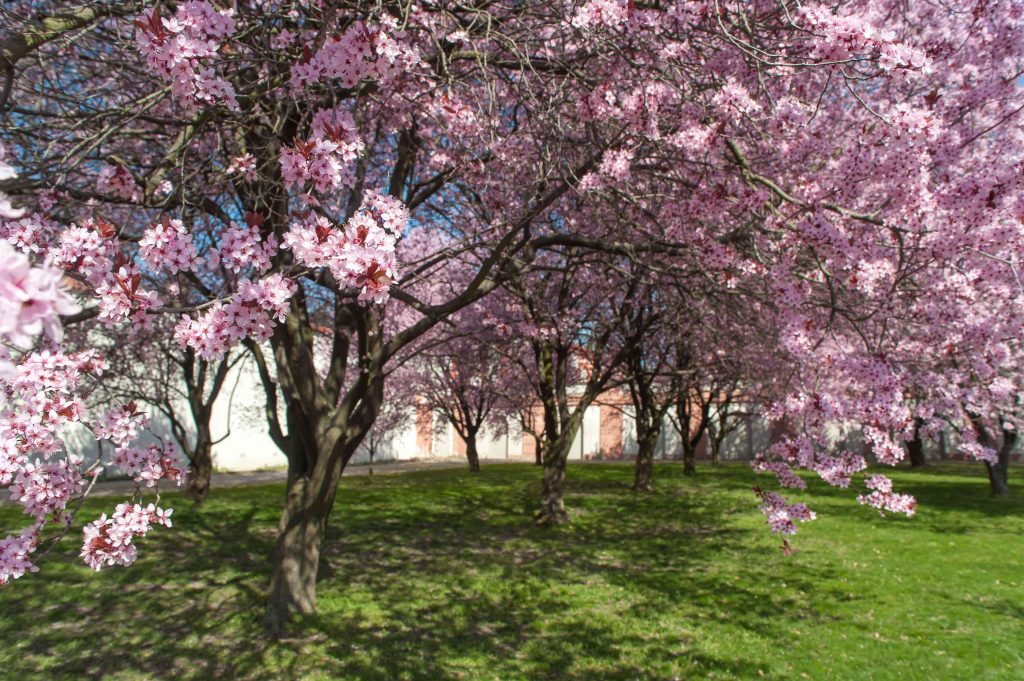The purpleleaf plum tree (Prunus cerasifera), also known as the cherry plum, is a popular flowering specimen tree for home landscapes. It’s a relatively small tree with a rounded growth habit. It produces fragrant, five-petaled pale pink to white flowers in the spring that are roughly an inch across, which then turn to small fruits. The elliptical leaves can range in color from purple to green.
This tree has a moderate growth rate of about one to two feet per year. It’s best planted in the early spring or fall. It is a larval host plant for the Eastern Tiger Swallowtail butterfly (Papilio glaucus).
The stems, leaves, and seeds contain cyanide and are toxic, especially in the process of wilting; they are mildly toxic to humans, and toxic to dogs, cats, and horses.
| Common Names | Purpleleaf plum, cherry plum |
| Botanical Name | Prunus cerasifera |
| Family | Rosaceae |
| Plant Type | Tree |
| Mature Size | 15–25 ft. tall, 15–25 ft. wide |
| Sun Exposure | Full, partial |
| Soil Type | Loamy, well-drained |
| Soil pH | Acidic, neutral |
| Bloom Time | Spring |
| Flower Color | Pink, white |
| Hardiness Zones | 4–9 (USDA) |
| Native Area | Europe, Asia |
| Toxicity | Toxic to humans, toxic to pets. |
Purpleleaf Plum Care
The purpleleaf plum is a relatively short-lived tree, lasting only around 20 years, and it requires a bit of maintenance. Yet growers still love it for its beautiful spring flowers and rich leaf coloring.
In terms of its care, plan to water your tree throughout the growing season (spring to fall) if rainfall is insufficient. This tree also will likely benefit from annual feeding and pruning.
Grown for its colorful dark purple foliage, it produces small edible red fruits 1¼” in diameter that ripen in late summer: a perfect snack food for songbirds and small animals. You might want to choose a planting location away from walkways and driveways that receive a lot of foot traffic so that you don’t step on fruit that falls to the ground.
Light
This tree grows best in full sun. Six to eight hours of sunlight per day results in the most vibrant purple leaf color. If the tree is planted in a location that’s too shady, its leaves lose their purple color and can become green.
Soil
The purpleleaf plum likes loamy soil with excellent drainage and an acidic to neutral soil pH (5.0 to 7.0). It also can tolerate clay and sandy soil. It does not tolerate compacted soil or pollution and will struggle to grow in urban conditions.
Water
This tree prefers a moderate amount of soil moisture. Once it’s established, it does have some drought tolerance. It likely will need extra waterings during long stretches without rainfall or in extreme summer heat.
Temperature and Humidity
The purpleleaf plum is fairly tolerant both to cold and to heat. It’s hardy down to minus 20 degrees Fahrenheit and can handle the high summer temperatures within its growing zones if it’s adequately watered. Humidity also is typically not an issue.
Fertilizer
This tree likes moderately rich soil. Fertilize annually in the spring as new growth begins with an all-purpose fertilizer, following the product label instructions. If your soil is rich and fertile, you might only need to fertilize every two to three years.
Types of Purpleleaf Plum
There are several varieties of Prunus cerasifera, including:
- Prunus cerasifera ‘Thundercloud’: This variety features deep reddish-purple leaves.
- Prunus cerasifera ‘Krauter Vesuvius’: This variety looks similar to ‘Thundercloud’ but has even darker spring foliage and grows slightly smaller.
- Prunus cerasifera ‘Newport’: The leaves on this tree are a bronze-purple in the spring, deep purple in the summer, and reddish-purple in the fall.
- Prunus cerasifera ‘Nigra’: This tree has bronze leaves in the spring, very dark purple leaves in the summer, and orange-red leaves in the fall.
- Prunus cerasifera ‘Purple Pony’: This is a dwarf variety that only reaches around 10 to 12 feet in height and spread.
Pruning
Purpleleaf plum doesn’t need an excessive amount of pruning each year except for maintaining the desired shape. Prune after the tree has flowered or you might remove next year’s flower buds. Dead, damaged, or diseased branches can be removed any time of year.
Propagating Purpleleaf Plum
If you have the patience, rather than buying a sapling or young tree from a nursery, you can propagate purpleleaf plum from softwood cuttings:
- In the spring when the first flower buds appear, cut a shoot about 1/8 inch in diameter and six inches long with a sharp, clean knife. Remove all leaves except for the top three or four.
- Dip the cut end in rooting hormone and plant it in a four-inch pot filled with damp potting mix.
- Keep the cutting in indirect light outdoors and water it regularly. New growth is a sign that roots are forming.
- Before planting it in the landscape, let the potted sapling grow for a couple of seasons, transplanting it to a larger pot if necessary. The stronger the sapling when you transplant it, the better its chance of survival.
As most purpleleaf plums are cultivars, growing them from seed is not recommended, because it won’t produce a tree true to type.
Potting and Repotting
Purpleleaf plum is a small-to-medium-sized specimen tree that is meant to be planted outdoors in the landscape and is not suitable for growing in containers.
Overwintering
Purpleleaf plum is hardy to USDA zone 4 and does not require winter protection.
Common Pests & Plant Diseases
This tree is prone to several pests and diseases. Insects that might infest the tree include Japanese beetles, mealybugs, borers, tent caterpillars, and scales.
Common diseases include leaf spot, gray mold, black knot, and cankers. Symptoms of pests and diseases include discolored, wilted, or otherwise damaged foliage, along with poor growth and flowering.
Ensuring proper growing conditions and good airflow among the branches can help to prevent many problems.
How to Get Purpleleaf Plum to Bloom
If your tree isn’t blooming, it could be due to a cold snap after unseasonably warm weather in the late winter or early spring, which damages the buds. Another possibility is improper pruning in the spring when you accidentally removed the flower buds. To ensure your tree blooms next year, only prune it right after it blooms.
-
Can I eat purpleleaf plum fruit?
Purpleleaf plum is grown for its ornamental qualities rather than its fruit. The fruits are edible but not very palatable and the seeds are toxic.
-
Is purpleleaf plum self-pollinating?
The trees are self-pollinating and they can be pollinated by other plum trees nearby so you only need one tree for fruit production. Note though that this is an ornamental tree. If you want to grow a plum tree for its fruit, it is better to select a plum species that was bred for its fruit.
-
What’s the difference between purpleleaf plum and purple leaf sand cherry?
Purple leaf sand cherry is a shrub, not a tree like the purpleleaf plum. The sand cherry is also more hardy than the purpleleaf plum.
Read the full article here














